Abstract
Circularly polarized luminescence (CPL) materials have been widely used in the fields of bioimaging, optoelectronic devices, and optical communications. The supramolecular interaction, involving harnessing non-covalent interactions between host and guest molecules to control their arrangements and assemblies, represents an advanced approach for facilitating the development of CPL materials and finely constructing and tuning the desired CPL properties. Cyclodextrins (CDs) are cyclic natural polysaccharides, which have also been ubiquitous in various fields such as molecular recognition, drug encapsulation, and catalyst separation. By adjusting the interactions between CDs and guest molecules precisely, composite materials with CPL properties can be facilely generated. This review aims to outline the design strategies and performance of CD-based CPL materials comprehensively and provides a detailed illustration of the interactions between host and guest molecules.
1. Introduction
Circularly polarized luminescence (CPL) materials provide crucial support for the development of some fields such as 3D displays, biological imaging, and information storage and encryption [,,,,,]. CPL can be generated through a polarizer and quarter-wave plate; however, the significant energy loss during this process and the bulky setup constrain its applications []. Fortunately, scientists have discovered that some substances, including coordinative compounds, organic small molecules, polymers, liquid crystal materials, and so forth, can exhibit CPL activity [,,,,,]. The ability of a substance to emit circularly polarized light is evaluated by the dissymmetry factor (glum), defined as
where IL and IR are the intensities of the left and right circularly polarized emission, respectively []. glum ranges from +2 to −2, corresponding to an optimal emission of left or right-handed CPL, respectively. When glum = 0, it indicates that there is an emission of non-circularly polarized light. The glum values of all CPL materials developed usually fall within the range of 10−4 to 10−3 at present. Therefore, achieving a larger glum has become the fervent and indefatigable pursuit of thousands upon thousands of scientists.
glum = 2 (IL − IR)/(IL + IR)
Supramolecular assembly usually involves non-covalent interactions such as hydrogen bonding, van der Waals forces, and π-π stacking between molecules, enabling host and guest molecules to form stable structures with specific shapes and functionalities under appropriate conditions []. The supramolecular assembly has been used as an efficient strategy for the construction of CPL materials. For example, cyclodextrins (CDs) are natural macrocyclic structures formed by linking six, seven, or eight D-glucose molecules via α-1,4 glycosidic bonds, called α-, β-, and γ-CD, respectively, which feature a hydrophobic inner cavity and hydrophilic outer surface and have the ability to form inclusion complexes with numerous organic and inorganic compounds, thereby bringing about diverse assemblies with specific properties and functions []. With the extensive applications in the fields of chemistry and biology, CDs hold significant potential for a wide range of industrial applications [,,].
In addition, the combination of fluorescent dyes with CDs to produce composite materials with CPL emission has developed rapidly, and CD derivatives are utilized in preparing nanomaterials and nanostructures with CPL performance. The multilevel self-assembly strategy is employed to amplify the glum of CPL materials. Host–guest complexes initially form basic unit structures, which can further assemble into advanced structures such as nanospheres, nanotubes, and helical architectures. This process is typically regulated by physical, chemical, and environmental factors, thus enabling the production of materials or devices with specific functions and properties. Under the driving force of host–guest chemistry, the excellent encapsulation and molecular recognition properties of CDs provide new insights and methods for the design and fabrication of excellent nanomaterials (Figure 1).
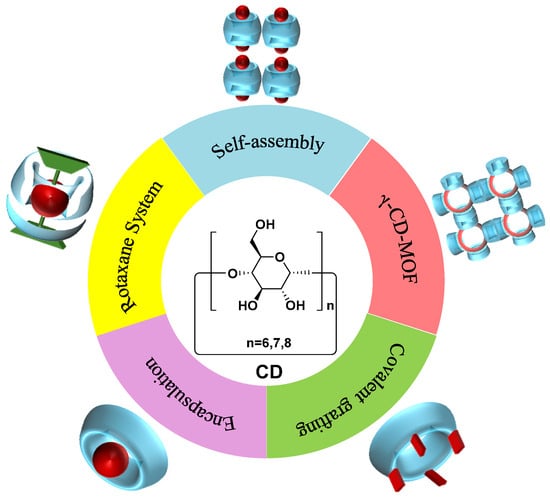
Figure 1.
Schematic illustration of design strategies for CD-based CPL materials.
Given the significant role of CDs in CPL emission, herein, we review the strategies for constructing CPL materials based on CDs in the past decade and prospect their future development. It is believed that this summary of strategies for constructing CPL materials by CDs will be informative and helpful for CPL material developers.
2. CPL Materials Based on Cyclodextrins
2.1. Covalent Grafting of Achiral Fluorescent Dyes with Cyclodextrins
This strategy fundamentally involves covalently linking CDs (host molecules) and fluorescent dyes (guest molecules) via ester or amide bonds. Subsequently, CPL emission is induced by intermolecular or intramolecular non-covalent interactions. Liu et al. [] choose dansyl as the emitting moiety and β-CD as the chiral source to synthesize rotaxane 1 with thermo-reversible CPL performance. Rotaxane 1 shows three different conformations in H2O, DMSO, and CH3OH (Figure 2a). In a low concentration (3 mM) of aqueous solution, rotaxane 1 forms channel-type 1A with blue emission. However, at high concentrations (10 mM), it can self-assemble into Cage-type 1B with green emission (Figure 2b). The cyclic thermal test for 1A and 1B shows that the fluorescence quantum yield (Φf) of 1A has reversible changes within the range of 90%–80%. In contrast, the Φf of 1B decreases noticeably from 80% to 72% after cycling. While the fluorescence intensity of the assemblies decreases with increasing temperature, the glum of 1A increases and exhibits a reversible thermo-regulated CPL property between 25 °C (glum = 0.024) and 90 °C (glum = 0.040). However, under the same conditions, the glum of 1B continuously decreases with increasing cycle numbers with no thermo-reversibility. In addition, the assembly of the unpotted emitter 1Agg exhibits no significant temperature responsiveness (Figure 2c–g). The variable-temperature powder X-ray diffraction (VT-PXRD) patterns reveal that the flexible framework of β-CD undergoes an adaptive reshaping of its hydrogen bonding model with increasing temperature, causing a slight deformation in the cyclic skeleton structure. This limits the nanospace of the β-CD cavity for the dansyl moieties, thus achieving thermally enhanced CPL emission.
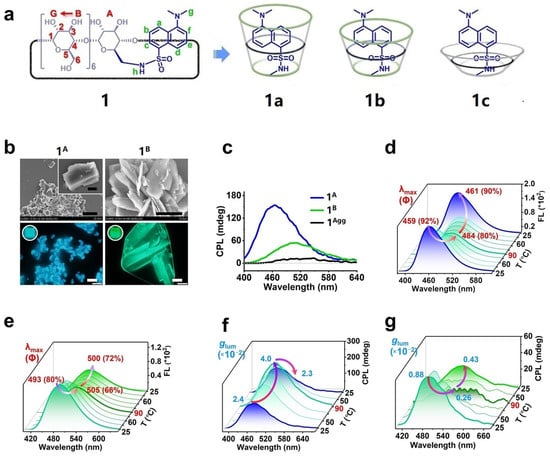
Figure 2.
(a) Structures of 1a–1c; (b) SEM and fluorescence images of 1A and 1B; (c) CPL spectra of 1A, 1B, and 1Agg; (d,e) temperature-dependent FL spectra of 1A and 1B; (f,g) temperature-dependent glum and CPL emission spectra of 1A and 1B [].
Shigemitsuk et al. [] synthesize α-CD modified with six pyrenyl groups to obtain pyrene–CDs 2. Under the influence of α-CD, the pyrene units adopt a chiral arrangement, as is evident by the cotton effect observed in the circular dichroism spectrum (Figure 3a–c). Simultaneously, compound 2 shows a strong CPL signal associated with the excited state emission band, with a maximum glum = 1.2 × 10−2 (Figure 3d). However, compound 3 with one pyrene-modified derivative of α-CD exhibits no CPL signal (Figure 3d). Further spectroscopic studies reveal that the formation of pyrene excimers in a crowded environment is crucial for CPL anisotropy. TD-DFT calculation indicates that the formation of the excimer of compound 2 is ascribed to the nearly parallel pyrene units P1 and P2 in the excited state, and the distance between the carbon atoms of P1 and P2 decreases from 4.8 Å to 3.8 Å.
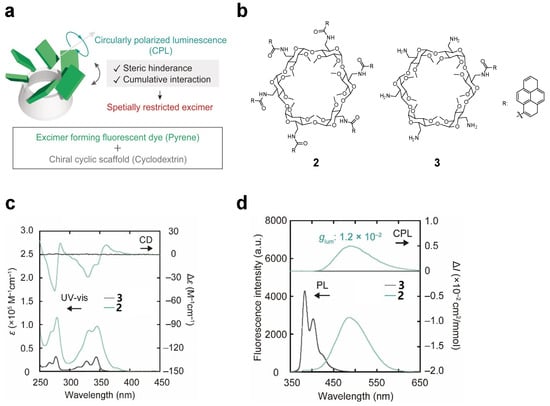
Figure 3.
(a) CPL emission from pyrene-modified α-CD scaffold; (b) chemical structures of 2 and 3; (c) circular dichroism (top) and UV-vis absorption spectra (bottom) of 2 and 3; (d) CPL (top) and FL (bottom) spectra of 2 and 3 [].
Yang et al. [] further demonstrate that pyrene-modified γ-CD derivatives 4–6 (Figure 4a,b) can aggregate to nanostructures in water, where the pyrene units are well confined within the enclosed chiral cavity of γ-CD (Figure 4d). The host–guest complexes exhibit a significant CPL signal, with a maximum glum = 5.3 × 10−2 (Figure 4c).
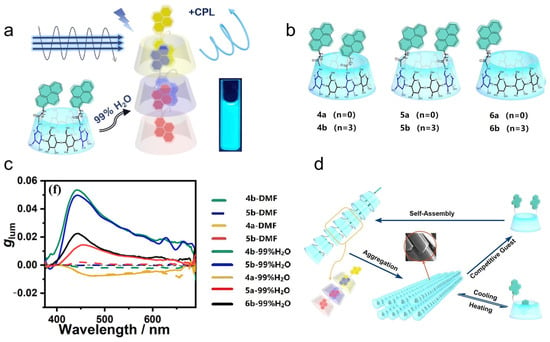
Figure 4.
(a) The self-assembly of dipyrene-substituted γ-CD in H2O shows significant CPL activity; (b) the structures of pyrene-substituted γ-CD 4–6; (c) the variation in glum of 4–6 in DMF and 99% H2O aqueous solution; (d) schematic representation of the self-assembly of 4–6 [].
2.2. Host–Guest Interaction between Cyclodextrins and Achiral Fluorescent Dyes
Duan et al. [] report dendritic hydrogel 7, which can self-assemble into a helical nanofiber (Figure 5a). Additionally, 7 is capable of interacting with CDs through host–guest recognition, forming supramolecular structures with CPL emission. To some extent, the CPL signal of hydrogel 7 decreases with increasing pH values and the maximum glum is 6.87 × 10−3 at pH = 3 (Figure 5b). Due to the significant reduction in strong π-π stacking of the pyrene groups caused by the encapsulation between 7 and β-CD, the CPL emission of 7@β-CD shows a blue shift. Furthermore, the formation of a 2:1 complex of 7@γ-CD leads to a significant enhancement in CPL emission centered at 480 nm. However, no interaction is observed between 7 and α-CD (Figure 5c).
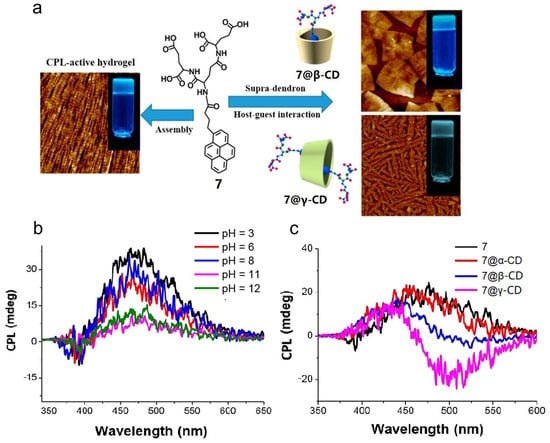
Figure 5.
(a) AMF images of 7 assembled with β-CD, γ-CD, and itself; (b) CPL spectra of 7 under different pH; (c) CPL spectra of 7, 7@β-CD, and 7@γ-CD [].
Subsequently, Duan et al. [] discover that β-CD and sodium dodecyl sulfate (SDS) can assemble into chiral nanosheets, which further self-assembles into helical microtubes through intermolecular hydrogen bonding (Figure 6). Due to the chiral transfer of β-CD, the microtubes loaded with dyes exhibit chirality and CPL emission. Notably, the helical microtube doped with ThT shows the strongest CPL emission with glum = ±0.1.
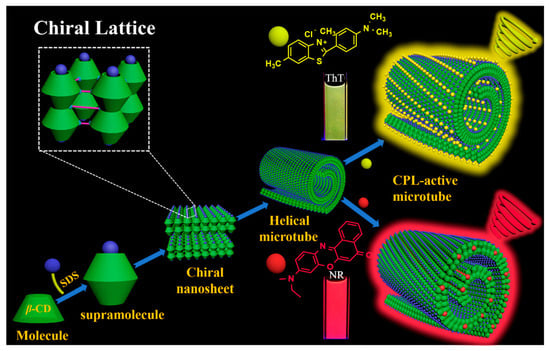
Figure 6.
Supramolecular assembly of β-CD and SDS and CPL emission.
Drawing inspiration from Duan et al. [], Yan et al. [] introduce a novel temperature-triggered reversible CPL system. The temperature-induced disassembly of the aggregate leads to the release of β-CD carrying a fraction of the ThT dyes (Figure 7a). According to the H-K rule, they effectively modulate the left- and right-handed CPL emission in the self-assembly system of ThT-SDS@2β-CD by controlling the temperature. In detail, ThT-SDS@2β-CD microtubes tend to co-assemble due to strong electrostatic interactions at 25 °C, resulting in right-handed CPL emission centered at 580 nm. With the increasing temperature, hydrophobic interactions cause ThT to be concealed in β-CD, while its positive charge remains outside. Consequently, negative circular dichroism signals are induced, as followed by the H-K rule (Figure 7b–d). When the temperature reaches 30 °C, ThT attached to SDS@β-CD shows right-handed CPL emission concentrated at 580 nm. Meanwhile, as the temperature rises up to 35 °C, the left-handed CPL emission undergoes inversion, indicating that the ThT is recognized by β-CD due to electrostatic interactions with SDS. However, CPL emission disappears as the ThT-SDS@2β-CD system is disrupted at 40 °C (Figure 7d–f).
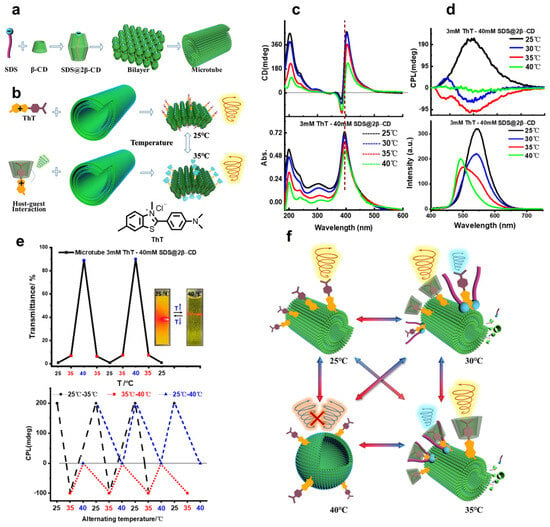
Figure 7.
(a) Self-assembly of SDS@2β-CD; (b) reversal of CPL emission of non-chiral dye ThT with SDS@2β-CD from 25 °C to 35 °C; (c) circular dichroism (top) and UV-vis absorption (bottom) spectra of ThT-SDS@2β-CD at different temperatures; (d) CPL (top) and FL (bottom) spectra of ThT-SDS@2β-CD at different temperatures; (e) top—variation in the transmittance of the ThT-SDS@2β-CD at 650 nm with varying temperature; bottom—switchable CPL inversion cycles (at 590 nm) of 3 mM ThT/40 mM SDS@2β-CD suspension by alternately changing temperature; (f) schematic representation of CPL switching modes of ThT-SDS@2β-CD at different temperatures [].
Takashima et al. [] prepare a series of complexes exhibiting CPL emission concentrated at 480 nm, composed of γ-CD and hydrophobic pyrene derivatives. Among them, complex 8 shows the highest glum (+2.2 × 10−3) and 0.6 (Figure 8). They propose that the hydroxyl group of serine forms hydrogen bonds with γ-CD, inducing two pyrenyl groups to twist into a stable chiral excimer.

Figure 8.
The structure of γ-CD-1-(aminocarbonyl) pyrene complex 8 and the schematic illustration for a possible configuration in pyrene/γ-CD systems [].
Liu et al. [] incorporate cyanostilbene-conjugated gelator 9 into CDs to result in extensive CPL emission (Figure 9a). The assemblies show a slight increase in glum compared to 9 individually (Figure 9c). Particularly, due to the large cavity of γ-CD, the gelator 9 can undergo Z-E isomerization. At this point, the assembly can form into a nanosphere, and CPL emission becomes silenced. Heating the system causes the assembly to transform into a nanotube; in this case, the complex exhibits CPL emission again (Figure 9b).
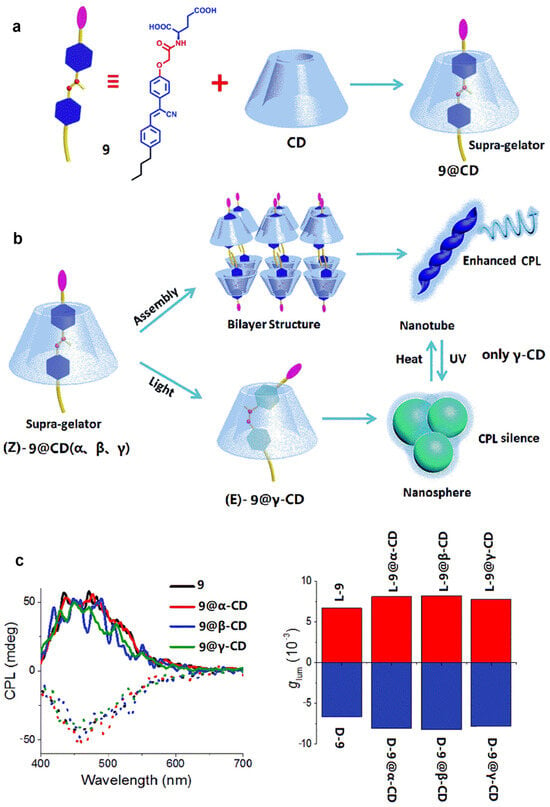
Figure 9.
(a) Cyanostilbene-conjugated gelator 9 and supra-gelator 9@CD; (b) top—self-assembly of supra-gelator 9@CD; bottom—morphological transformation from nanotubes to nanospheres of 9@γ-CD; (c) left—CPL spectra of gelator 9 and supra-gelator 9@CD; right—glum of gelator 9 and supra-gelator 9@CD [].
After that, Liu et al. [] synthesize novel non-chiral guest molecule 10, featuring a conjugated connection between pyrene and adamantane. With dual host–guest interaction sites, compound 10 serves as a platform for exploring different CD-induced CPL emissions (Figure 10). Due to the differences in the volume of the pyrene and adamantane groups, as well as their affinity for the CD cavity, different types of CDs can selectively encapsulate the two parts of guest 10, thereby resulting in different CPL emissions. As anticipated, α-CD is too small to accommodate any portion of 10, thus precluding CPL emission. At low concentrations, β-CD captures the adamantane moiety selectively, with pyrene encapsulation occurring as the concentration increases, leading to opposite CPL emission. On the other hand, γ-CD exclusively recognizes the pyrene moiety, thereby adhering to the H-K rule, with the CPL emission remaining unaltered. However, its encapsulation behavior of 10 varies at different concentrations.
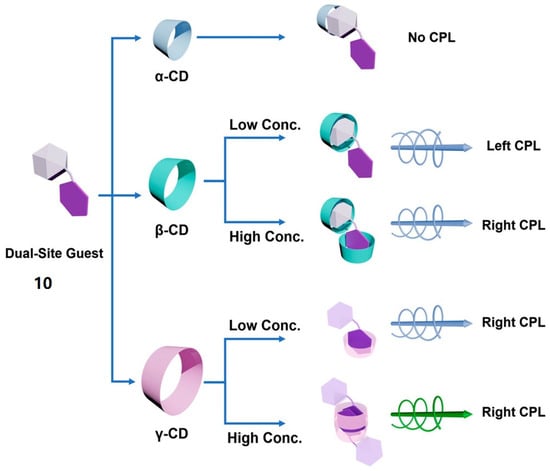
Figure 10.
Illustration of selective CPL induction of 10 by different CDs [].
Subsequently, Liu et al. [] discover that CDs in the aqueous solution can form Langmuir–Schaefer (LS) films with amphiphilic enantiomer 11 at the interface, exhibiting nanofiber characteristics and CPL activity enhancement (Figure 11a). The chiral synergy observed between L-11 and its CD hosts leads to an amplified circular dichroism, whereas the conflicting molecular chirality between D-11 and its associated CD hosts causes a decrease. However, the 2D LS films can stabilize the aggregation state of 11, thereby enhancing CPL emission (Figure 11c). In α, β, and γ-CD aqueous solutions, D-11 displays a maximum glum of −12.4 × 10−3, −9 × 10−3, and −10.8 × 10−3, accompanied by enhancements of 2.48, 1.80, and 2.16 times, respectively. On the other hand, L-11 manifests glum = 18.4 × 10−3, 17.1 × 10−3, and 19.2 × 10−3, indicating corresponding increases of 3.54, 3.29, and 3.69 times (Figure 11b).
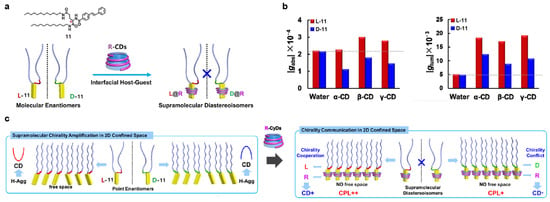
Figure 11.
(a) Structure of amphiphilic compound 11 and its host–guest interaction with CDs; (b) changes in gabs (left) and glum (right) after self-assembly of D/L-11 and CDs; (c) chirality amplification effect of 11@CD assemblies [].
Kitamatsu et al. [] disclose that incorporating γ-CD into chiral bipyrenyl oligopeptides containing stereocenters of the same chirality can control the wavelength, intensity, and signal of stimulated supramolecular CPL. After adding γ-CD, LL-12 to LL-15 exhibit CPL emission in their photo-excited state (Figure 12 and Table 1). Upon the addition of γ-CD, the emission positions of CPL signals from LL-12 to LL-14 have no obvious change, but there is a larger blue-shift observed for LL-15. While CPL emission remains relatively stable for LL-13/γ-CD, significant increases are observed for both LL-12/γ-CD and LL-14/γ-CD. Additionally, LL-15/γ-CD undergoes a transition. In general, the glum values of LL-12/γ-CD to LL-15/γ-CD are either close to or slightly higher than those of LL-12 to LL-15, with LL-14/γ-CD showing a significant increase. However, there is no change in the inclusion behavior of another chiral oligopeptide with bipyrenyl groups in γ-CD. The supramolecular CPL emission regions for DD-12 to DD-14 remain unchanged. In contrast, DD-15/γ-CD exhibits the CPL signals in two distinct bands at 434 and 497 nm, attributed to differences in the pyrene overlap. The CPL emission sharply decreases for DD-13/γ-CD and DD-15/γ-CD, while it is increased for DD-12/γ-CD and DD-14/γ-CD, and DD-15/γ-CD undergoes a transition. The glum values of DD-12/γ-CD and DD-15/γ-CD slightly increase, with DD-14/γ-CD displaying a significant increase compared to itself, respectively.
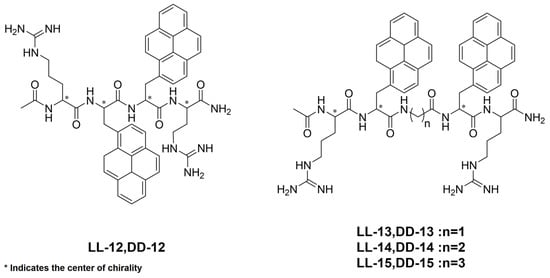
Figure 12.
The chemical structures of DD/LL 12 to DD/LL 15 []. * Indicates the center of chirality.

Table 1.
CPL emission and glum before and after the addition of γ-CD to compound 12–15 [].
Takashima et al. [] develop a series of host–guest systems (16/γ-CD to 19/γ-CD) with high QY in the solid state and CPL emission. From 16/γ-CD to 18/γ-CD, the 9-position-substituted anthracene segments can interact with the γ-CD cavity, inducing a right-handed chiral distortion (Figure 13a). Consequently, left-handed CPL emission is observed. However, due to the presence of a single-molecule inclusion entity in 19/γ-CD, its CPL emission is weak (Figure 13b).

Figure 13.
(a) Encapsulation of compounds 16–19 by γ-CD; (b) circular dichroism (left) and CPL (right) spectra of 16–19 before and after encapsulation with γ-CD [].
2.3. CPL Emission System Based on γ-CD-MOF
Liu et al. [] successfully encapsulate non-chiral luminescent emitters into γ-CD-MOF, resulting in CPL emission from violet to red (Figure 14). They find that the sizes of the emitters can influence the polarity of CPL emission. When the emitters are smaller than the γ-CD cavity, CPL emission becomes unpredictable. However, when the emitter sizes are comparable to γ-CD, a stable positive CPL emission can be achieved. Larger emitters can be selectively encapsulated into γ-CD-MOF.
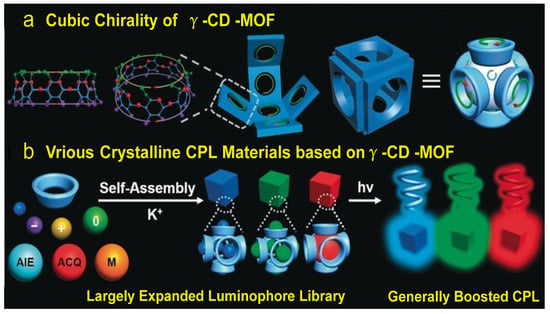
Figure 14.
(a) Illustration of the cubic chirality of γ-CD-MOF; (b) various crystalline CPL materials based on γ-CD-MOF and non-chiral emitters with enhanced CPL [].
Subsequently, Stoddart et al. [] further discover that the absence of non-covalent interactions between the fluorophores and γ-CD has only a slight weakening effect on the ability of γ-CD-MOF to encapsulate them. However, the co-crystallization of γ-CD with fluorescent dyes lacking non-covalent interactions may result in γ-CD wrapping the dyes in a disordered manner, predominantly forming a cubic γ-CD-MOF structure. This process leads to a loss of control over chiral transfer, culminating in random and unpredictable CPL emissions. Moreover, it is disclosed that 1-pyrenecarboxylate anions (20) can exhibit significant non-covalent interactions with γ-CD in solution and form a helical chiral structure with γ-CD-HF (Figure 15a,b). These alignments result in specific optical and thermal properties, such as controllable CPL emission, with glum = +3.5 × 10−3 for 20/γ-CD-HF.
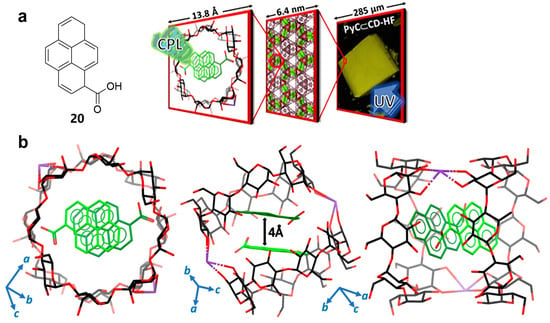
Figure 15.
(a) Chemical structure of 1-pyrene carboxylic acid 20 and schematic representation of CPL emission for 20/γ-CD-HF; (b) solid-state X-ray diffraction of 20/γ-CD-HF [].
2.4. Cyclodextrin-Based Rotaxane Systems
Inouye et al. [] first develop double alkynylpyrene-threaded [] rotaxane 21. In aqueous solution, 21 exhibits bright yellow-green excimer emission with Φf up to 0.37. By comparing the chiral information exhibited in the circular dichroism and CPL spectra of the system, it is found that the chirality in both spectra originates from the same source. Due to the spatial constraints within the γ-CD cavity, the alkynylpyrene pair in 21 twists in an asymmetric manner and the chirality is retained in the excited state. Thus, the system displays intense CPL emission with glum = −1.5 × 10−2 at 480 nm (Figure 16).

Figure 16.
Synthetic scheme of bis(alkynyl) rotaxane 21 and its CPL emission [].
Liu et al. [] employ a mechanical interlocked strategy, utilizing β-CD as chiral wheels and a covalent organic framework consisting of C3 and Pyr as axles to construct the 2D polymer and realize a chiral polyrotaxane (2D CPR) monolayer with CPL emission (Figure 17). The structures and properties of 2D CPR can be regulated by the Feed(W/A) (the molar feeding ratios of β-CD to Pyr during the synthesis). When the Feed(W/A) reaches 8, the CPL emission of 2D CPR is strongest, resulting in the formation of large-sized high-quality monolayer films of 2D CPR.
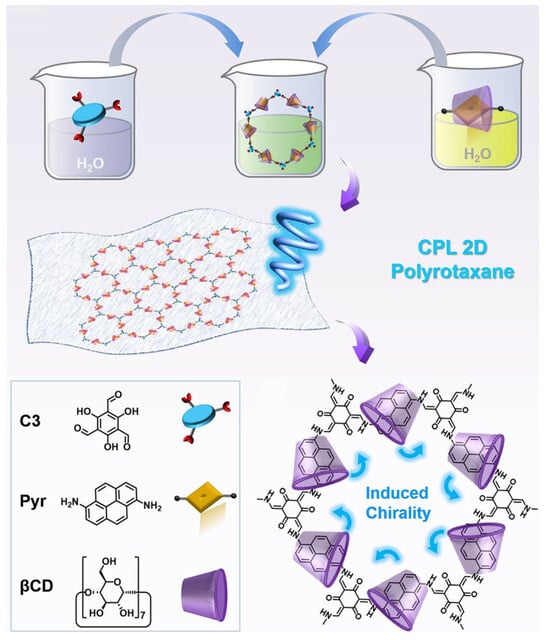
Figure 17.
Synthesis process for two-dimensional chiral polyrotaxane (2D CPR) with host–guest-induced skeleton chirality, which enables the induction of CPL for 2D CPR monolayers [].
3. Conclusions
From the above design strategies, it can be seen that the CD-based CPL materials have many advantages. Their structures can be finely tuned through chemical modification, thus influencing their CPL performance and offering increased flexibility in developing specific functional materials compared to other substances. In addition, the cyclic structure of CDs facilitates the efficient encapsulation of chiral molecules while effectively transmitting and amplifying chiral signals, which enhances the efficiency of CPL and holds substantial practical significance. Moreover, CDs and their derivatives generally exhibit excellent biocompatibility, particularly advantageous in biomedical applications such as bioimaging. CD-based materials can also show multiple luminescent properties by combining different fluorescent dyes, as demonstrated by the significant versatility for developing innovative optoelectronic devices and sensors. These materials typically feature robust chemical stability and environmental friendliness while delivering outstanding performance that meets sustainability requirements.
Of course, CDs exhibit selectivity and limitations in the size and shape of molecules, which may exclude larger or unconventional shapes. In addition, their performance requires specific conditions to exhibit excellent CPL, and this characteristic is significantly influenced by environmental factors such as solvent and pH, which limits their application in certain scenarios. Despite continuous advancements in research, CD-based CPL materials encounter challenges in commercialization and large-scale applications due to issues such as cost, stability, and market acceptance.
In summary, we review the development of CD-based CPL materials over the past decade. CPL emission can be generated by modifying CDs with non-chiral dyes directly, host–guest interactions, and the assembly of CDs with non-chiral dyes. Additionally, the unique cubic chirality of γ-CD-MOF cavities can be utilized to encapsulate non-chiral fluorescent dyes. Furthermore, the rotaxane system is also an effective strategy for constructing CPL systems containing CDs. Leveraging the inherent capabilities of CDs in guest encapsulation and hierarchical self-assembly, the meticulous control over the CPL performance of materials is achievable through nuanced manipulations of temperature, solvent, and pH, as well as other external environmental factors. However, the majority of materials currently exhibit glum values in the range of 10−4 to 10−3, indicating a considerable distance from practical applications. Fortunately, an increasing body of evidence suggests that gel or film systems constructed based on CDs often display stronger CPL emission. With the continuous development and refinement of innovative characterization techniques, coupled with the continuously profound exploration of host–guest interactions and supramolecular assembly by researchers, it is anticipated that CD-based CPL materials will unveil unparalleled prospects in the domains of optoelectronics and optical materials in the foreseeable future.
Author Contributions
C.Z., writing—original draft preparation; W.C., L.L., and J.L., writing—review and editing. All authors have read and agreed to the published version of the manuscript.
Funding
This research is funded by the National Natural Science Foundation of China (grants 22271167) and the National Key Research and Development (R&D) Program of China (2023YFD1700401 and 2022YFD170050201). We also thank the support from the Collaborative Innovation Center of Chemical Science and Engineering (Tianjin).
Institutional Review Board Statement
Not applicable.
Data Availability Statement
Not applicable.
Acknowledgments
We are grateful for the financial support from the National Natural Science Foundation of China (grants 22271167) and the National Key Research and Development (R&D) Program of China (2023YFD1700401 and 2022YFD170050201). We also thank the support from the Collaborative Innovation Center of Chemical Science and Engineering (Tianjin).
Conflicts of Interest
The authors declare no conflicts of interest.
References
- Yang, Y.; da Costa, R.C.; Smilgies, D.-M.; Campbell, A.J.; Fuchter, M.J. Induction of Circularly Polarized Electroluminescence from an Achiral Light-Emitting Polymer via a Chiral Small-Molecule Dopant. Adv. Mater. 2013, 25, 2624–2628. [Google Scholar] [CrossRef] [PubMed]
- Dai, Y.; Chen, J.; Zhao, C.; Feng, L.; Qu, X. Biomolecule-Based Circularly Polarized Luminescent Materials: Construction, Progress, and Applications. Angew. Chem. Int. Ed. 2022, 61, e202211822. [Google Scholar] [CrossRef] [PubMed]
- Fan, H.; Li, K.; Tu, T.; Zhu, X.; Zhang, L.; Liu, M. ATP-Induced Emergent Circularly Polarized Luminescence and Encryption. Angew. Chem. Int. Ed. 2022, 61, e202200727. [Google Scholar] [CrossRef] [PubMed]
- Han, J.; Guo, S.; Lu, H.; Liu, S.; Zhao, Q.; Huang, W. Recent Progress on Circularly Polarized Luminescent Materials for Organic Optoelectronic Devices. Adv. Opt. Mater. 2018, 6, 1800538. [Google Scholar] [CrossRef]
- Gong, Z.-L.; Zhu, X.; Zhou, Z.; Zhang, S.-W.; Yang, D.; Zhao, B.; Zhang, Y.-P.; Deng, J.; Cheng, Y.; Zheng, Y.-X.; et al. Frontiers in circularly polarized luminescence: Molecular design, self-assembly, nanomaterials, and applications. Sci. China Chem. 2021, 64, 2060–2104. [Google Scholar] [CrossRef]
- Sang, Y.; Han, J.; Zhao, T.; Duan, P.; Liu, M. Circularly Polarized Luminescence in Nanoassemblies: Generation, Amplification, and Application. Adv. Mater. 2020, 32, 1900110. [Google Scholar] [CrossRef]
- Yu, N.; Aieta, F.; Genevet, P.; Kats, M.A.; Gaburro, Z.; Capasso, F. A Broadband, Background-Free Quarter-Wave Plate Based on Plasmonic Metasurfaces. Nano Lett. 2012, 12, 6328–6333. [Google Scholar] [CrossRef]
- Lin, W.-B.; He, D.-Q.; Lu, H.-Y.; Hu, Z.-Q.; Chen, C.-F. Sign inversions of circularly polarized luminescence for helical compounds by chemically fine-tuning operations. Chem. Commun. 2020, 56, 1863–1866. [Google Scholar] [CrossRef]
- Deng, M.; Mukthar, N.F.M.; Schley, N.D.; Ung, G. Yellow Circularly Polarized Luminescence from C1-Symmetrical Copper(I) Complexes. Angew. Chem. Int. Ed. 2020, 59, 1228–1231. [Google Scholar] [CrossRef]
- He, Y.; Lin, S.; Guo, J.; Li, Q. Circularly polarized luminescent self-organized helical superstructures: From materials and stimulus-responsiveness to applications. Aggregate 2021, 2, e141. [Google Scholar] [CrossRef]
- Xia, Q.; Meng, L.; He, T.; Huang, G.; Li, B.S.; Tang, B.Z. Direct Visualization of Chiral Amplification of Chiral Aggregation Induced Emission Molecules in Nematic Liquid Crystals. ACS Nano 2021, 15, 4956–4966. [Google Scholar] [CrossRef] [PubMed]
- Li, M.; Li, S.-H.; Zhang, D.; Cai, M.; Duan, L.; Fung, M.-K.; Chen, C.-F. Stable Enantiomers Displaying Thermally Activated Delayed Fluorescence: Efficient OLEDs with Circularly Polarized Electroluminescence. Angew. Chem. Int. Ed. 2018, 57, 2889–2893. [Google Scholar] [CrossRef] [PubMed]
- Xu, L.; Gao, B.-R.; Xu, X.-H.; Zhou, L.; Liu, N.; Wu, Z.-Q. Controlled Synthesis of Cyclic-Helical Polymers with Circularly Polarized Luminescence. Angew. Chem. Int. Ed. 2022, 61, e202204966. [Google Scholar] [CrossRef] [PubMed]
- Yang, D.; Han, J.; Liu, M.; Duan, P. Photon Upconverted Circularly Polarized Luminescence via Triplet–Triplet Annihilation. Adv. Mater. 2019, 31, 1805683. [Google Scholar] [CrossRef] [PubMed]
- Whitesides, G.M.; Grzybowski, B. Self-Assembly at All Scales. Science 2002, 295, 2418–2421. [Google Scholar] [CrossRef] [PubMed]
- Wang, J.-Q.; Han, X.-N.; Han, Y.; Chen, C.-F. Advances in circularly polarized luminescence materials based on chiral macrocycles. Chem. Commun. 2023, 59, 13089–13106. [Google Scholar] [CrossRef]
- Crini, G. Review: A History of Cyclodextrins. Chem. Rev. 2014, 114, 10940–10975. [Google Scholar] [CrossRef] [PubMed]
- Cid-Samamed, A.; Rakmai, J.; Mejuto, J.C.; Simal-Gandara, J.; Astray, G. Cyclodextrins inclusion complex: Preparation methods, analytical techniques and food industry applications. Food Chem. 2022, 384, 132467. [Google Scholar] [CrossRef] [PubMed]
- Prochowicz, D.; Kornowicz, A.; Lewiński, J. Interactions of Native Cyclodextrins with Metal Ions and Inorganic Nanoparticles: Fertile Landscape for Chemistry and Materials Science. Chem. Rev. 2017, 117, 13461–13501. [Google Scholar] [CrossRef]
- Song, X.; Zhu, X.; Qiu, S.; Tian, W.; Liu, M. Self-Assembly of Adaptive Chiral [1]Rotaxane for Thermo-Rulable Circularly Polarized Luminescence. Angew. Chem. Int. Ed. 2022, 61, e202208574. [Google Scholar] [CrossRef]
- Shigemitsu, H.; Kawakami, K.; Nagata, Y.; Kajiwara, R.; Yamada, S.; Mori, T.; Kida, T. Cyclodextrins with Multiple Pyrenyl Groups: An Approach to Organic Molecules Exhibiting Bright Excimer Circularly Polarized Luminescence. Angew. Chem. Int. Ed. 2022, 61, e202114700. [Google Scholar] [CrossRef]
- Tu, C.; Wu, W.; Liang, W.; Zhang, D.; Xu, W.; Wan, S.; Lu, W.; Yang, C. Host–Guest Complexation-Induced Aggregation Based on Pyrene-Modified Cyclodextrins for Improved Electronic Circular Dichroism and Circularly Polarized Luminescence. Angew. Chem. Int. Ed. 2022, 61, e202203541. [Google Scholar] [CrossRef]
- Zhang, Y.; Yang, D.; Han, J.; Zhou, J.; Jin, Q.; Liu, M.; Duan, P. Circularly Polarized Luminescence from a Pyrene-Cyclodextrin Supra-Dendron. Langmuir 2018, 34, 5821–5830. [Google Scholar] [CrossRef] [PubMed]
- Liang, J.; Guo, P.; Qin, X.; Gao, X.; Ma, K.; Zhu, X.; Jin, X.; Xu, W.; Jiang, L.; Duan, P. Hierarchically Chiral Lattice Self-Assembly Induced Circularly Polarized Luminescence. ACS Nano 2020, 14, 3190–3198. [Google Scholar] [CrossRef]
- Wang, X.; Zhi, W.; Ma, C.; Zhu, Z.; Qi, W.; Huang, J.; Yan, Y. Not by Serendipity: Rationally Designed Reversible Temperature-Responsive Circularly Polarized Luminescence Inversion by Coupling Two Scenarios of Harata–Kodaka’s Rule. JACS Au 2021, 1, 156–163. [Google Scholar] [CrossRef]
- Sawai, M.; Matsumoto, S.; Mimura, Y.; Imai, Y.; Yamazaki, S.; Kanehisa, N.; Tohnai, N.; Nakata, E.; Takashima, H. Circularly polarized luminescence (CPL) characteristics of hydrophobic pyrene derivatives/γ-cyclodextrin (γ-CD) complexes in aqueous solution dissolved by grinding. J. Incl. Phenom. Macrocycl. 2022, 102, 133–142. [Google Scholar] [CrossRef]
- Ji, L.; He, Q.; Niu, D.; Tan, J.; Ouyang, G.; Liu, M. Host–guest interaction enabled chiroptical photo-switching and enhanced circularly polarized luminescence. Chem. Commun. 2019, 55, 11747–11750. [Google Scholar] [CrossRef]
- Yang, C.; Chen, W.; Zhu, X.; Song, X.; Liu, M. Self-Assembly and Circularly Polarized Luminescence from Achiral Pyrene-Adamantane Conjugates by Selective Inclusion with Cyclodextrins. J. Phys. Chem. Lett. 2021, 12, 7491–7496. [Google Scholar] [CrossRef]
- Yang, C.; Yang, D.; Zhu, X.; Meng, Y.; Liu, M. Circularly Polarized Luminescence of Langmuir–Schaefer Films of Amphiphilic Stilbene Enhanced via Interfacial Reaction with Cyclodextrins. Langmuir 2020, 36, 12366–12374. [Google Scholar] [CrossRef]
- Imai, Y.; Mimura, Y.; Motomura, Y.; Ikemura, R.; Shizuma, M.; Kitamatsu, M. Controlling Excimer-Origin Circularly Polarized Luminescence of Bipyrenyl-Arginine Peptides by Cyclodextrin in Water. Bull. Chem. Soc. Jpn. 2023, 96, 268–273. [Google Scholar] [CrossRef]
- Kakimoto, Y.; Ikemura, R.; Imai, Y.; Tohnai, N.; Yamazaki, S.; Nakata, E.; Takashima, H. Circularly polarised luminescence from excimer emission of anthracene derivatives complexed with γ-cyclodextrin in the solid state. RSC Adv. 2023, 13, 1914–1922. [Google Scholar] [CrossRef]
- Hu, L.; Li, K.; Shang, W.; Zhu, X.; Liu, M. Emerging Cubic Chirality in γCD-MOF for Fabricating Circularly Polarized Luminescent Crystalline Materials and the Size Effect. Angew. Chem. Int. Ed. 2020, 59, 4953–4958. [Google Scholar] [CrossRef] [PubMed]
- Kazem-Rostami, M.; Orte, A.; Ortuño, A.M.; David, A.H.G.; Roy, I.; Miguel, D.; Garci, A.; Cruz, C.M.; Stern, C.L.; Cuerva, J.M.; et al. Helically Chiral Hybrid Cyclodextrin Metal–Organic Framework Exhibiting Circularly Polarized Luminescence. J. Am. Chem. Soc. 2022, 144, 9380–9389. [Google Scholar] [CrossRef] [PubMed]
- Inouye, M.; Hayashi, K.; Yonenaga, Y.; Itou, T.; Fujimoto, K.; Uchida, T.-A.; Iwamura, M.; Nozaki, K. A Doubly Alkynylpyrene-Threaded [4]Rotaxane That Exhibits Strong Circularly Polarized Luminescence from the Spatially Restricted Excimer. Angew. Chem. Int. Ed. 2014, 53, 14392–14396. [Google Scholar] [CrossRef] [PubMed]
- Hu, L.; Zhu, X.; Yang, C.; Liu, M. Two-Dimensional Chiral Polyrotaxane Monolayer with Emergent and Steerable Circularly Polarized Luminescence. Angew. Chem. Int. Ed. 2022, 61, e202114759. [Google Scholar] [CrossRef] [PubMed]
Disclaimer/Publisher’s Note: The statements, opinions and data contained in all publications are solely those of the individual author(s) and contributor(s) and not of MDPI and/or the editor(s). MDPI and/or the editor(s) disclaim responsibility for any injury to people or property resulting from any ideas, methods, instructions or products referred to in the content. |
© 2024 by the authors. Licensee MDPI, Basel, Switzerland. This article is an open access article distributed under the terms and conditions of the Creative Commons Attribution (CC BY) license (https://creativecommons.org/licenses/by/4.0/).